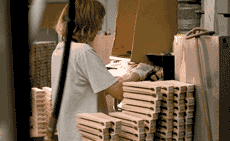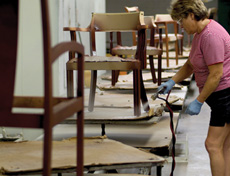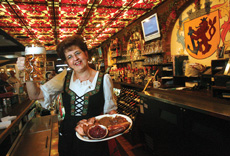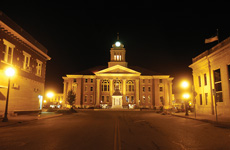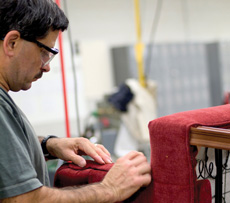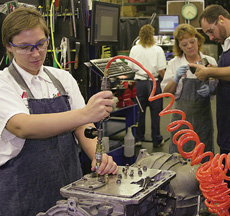Community Profile: Knock on Wood, Jasper, Ind., Economy Remains Strong
Hardwood from local forests, coupled with fine craftsmanship, got Jasper's furniture-making business going in the late 1800s. Today, many of the thick forests are gone, and most companies bring in their lumber by rail. Even so, this small southern Indiana town still relies on skilled workers to build desks, cabinets and other furniture.
|
Workers at Kimball International make furniture. |
|
The Schnitzelbank Restaurant is popular with Jasper residents, many of whom are of German ancestry. |
|
The courthouse is a focal point downtown. |
Such manufacturing accounts for about 27 percent of employment in Dubois County, according to the Bureau of Labor Statistics, making it the area's leading industry. Statewide, about 1 percent of workers depend on this industry for their paychecks.
In all, 5,800 workers in the county are employed just by furniture maker Kimball International and by MasterBrand Cabinets, both based in Jasper. Kimball sells under brands such as Kimball Office, Kimball Hospitality and National. MasterBrand's lines include Aristokraft, Kemper and Omega Cabinetry. Other important builders of wooden furniture in Dubois County are OFS Brands (formerly Styline Industries), Best Home Furnishings, Jasper Seating and JOFCO.
MasterBrand has made several adjustments over the past few years in order to remain competitive, says Rich Forbes, the president and CEO of the home and hardware branch of Fortune Brands, the parent of MasterBrand. The cabinet maker consolidated product lines, shut down a plant in Canada and, through attrition, trimmed its Dubois County work force.
MasterBrand did $2.1 billion in sales last year in kitchen cabinetry and bathroom vanities. The company operates 18 plants in eight U.S. states, mostly in rural areas. Customers demand speedy service, and MasterBrand's smaller domestic competitors led the drive to faster lead times on orders, Forbes says. Orders that took three weeks to fill a few years ago now get delivered in a week, he says.
The need to be timely makes it impractical to produce a large percentage of pieces outside the U.S. market and then ship those pieces across the ocean. Only about 10 percent of MasterBrand manufacturing gets completed in China, for instance.
"It makes sense for us to do most of our business in the United States," Forbes says. "When you're talking about cabinets, you're talking about, in a lot of cases, heavy pieces. It's better to do the work here, rather than, say, in China and then ship it to the United States."
Comparing the industry of today with the industry of 10 or 15 years ago, Forbes says technology is improving and customization is increasing. Customers can choose from many more colors and styles in 2007 than they could in 1997. Forbes expects that trend to continue, but cabinets or furniture probably aren't going to get from the plant to the store or office any quicker than they get there now.
"You can only get so fast with your lead times, but you can continue to offer people more and more choices," Forbes says. Manufacturing abroad, not just in Asia but also in Eastern Europe, also will increase, he says.
Kimball, located just a couple of blocks from MasterBrand, has also felt the effects of low-cost overseas competition. Through restructuring in 2001 and 2003, the 57-year-old business shut down 10 manufacturing facilities—six in Indiana and one each in Florida, Kentucky, Mississippi and North Carolina. In 2006, Kimball consolidated a Tennessee factory into one in Indiana, and one plant in Mexico into another plant in that country. The company reduced its employment by approximately 600 positions in Dubois County, but Kimball spokesman Martin Vaught says many workers were offered alternate positions within the company and many others have since been rehired.
Kimball also has eliminated some of its less profitable offerings over the past five years, such as veneer slicing, the process of making thin pieces of wood that workers glue onto particle board, fiberboard, etc. for doors, cabinets and other furniture pieces.
Kimball consolidated some product lines into one plant. "The plants become more efficient, and the people who work there become experts at making that particular piece," Vaught says. "The hours are also more regular. That provides more personal stability for employees. You're not working 30 hours one week and 50 hours the next week."
One important growth area for Kimball is in the electronics division, an offshoot of the company's piano business. Kimball quit making pianos in 1996 after several years of declining sales. Vaught says that the piano market tumbled in large part because the tradition of singing songs around the piano on a Saturday night went the way of the black and white TV.
Kimball Electronics builds roll-over sensors for vehicles, airbag controls, anti-lock braking modules, and a variety of other medical and public safety electronics products.
Kimball Electronics has plants in Jasper and two other locations in Indiana. It also has one plant each in Mexico, Thailand, Poland and China. The division did almost $498 million in net sales in 2006, a 13 percent increase from 2005. Numbers like that make company leaders optimistic.
"Were there nervous times a few years ago?" Vaught asks rhetorically. "Absolutely. Kimball really had never had bad times before. We had to cut waste and cut costs, in large part because of the overseas competition we were facing."
He adds, "It's still not a level playing field as far as costs and environmental regulations and in other areas, but the thing everyone needs to understand is that the global economy is not going away. It's just going to become more global."
Jasper business and civic leaders plan to keep competing. Mark Schroeder, the president of Jasper-based German American Bancorp, points to the creation of a county-wide economic development group in 2000, the Dubois County Area Development Corp. (DCADC). Before that, Schroeder said, the county didn't feel that it needed an economic development group.
"When you're humming along and then you get several plant closings, that's a real wake-up call," Schroeder says.
The DCADC, with help from management experts at Purdue University in West Lafayette, Ind., put together programs that encouraged area companies to streamline supply chains and otherwise better compete in the global marketplace.
After briefly going through what economic development head Bob Grewe calls "a little hiccup"—the county unemployment rate hit 4.8 percent in March 2004—the Jasper economy seems to be humming along again. The county's July unemployment rate of 2.9 percent was among the lowest in the state.
"The county needed to set an economic course for the future," he says. "I think people feel better about things now than they did just a few years ago."
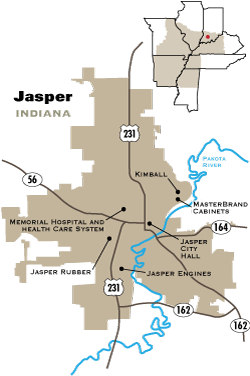
Jasper, Ind.
| BY THE NUMBERS | ||
| Population | ||
| City | 13,976 (2006) | |
| County | 41,212 (2006) | |
| County Labor Force | 22,594 (July 2007) | |
| County Unemployment Rate | 2.9 percent (july 2007) | |
| Top Employers | ||
| Kimball International | 3,400 | |
| MasterBrand Cabinets | 2,400 | |
| OFS Brands | 1,600 | |
| Jasper Engines and Transmissions | 1,500 | |
| Memorial Hospital and Health Center | 1,000 | |
Views expressed in Regional Economist are not necessarily those of the St. Louis Fed or Federal Reserve System.
For the latest insights from our economists and other St. Louis Fed experts, visit On the Economy and subscribe.
Email Us


